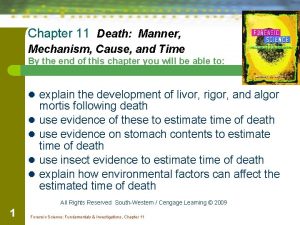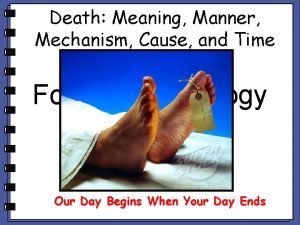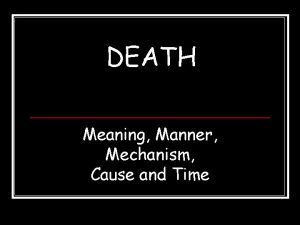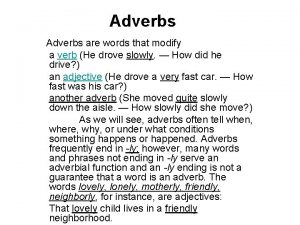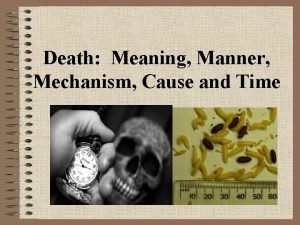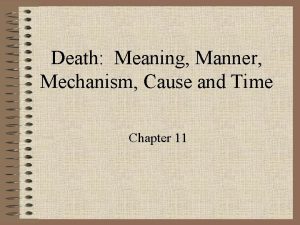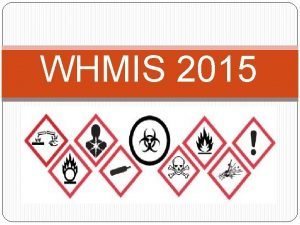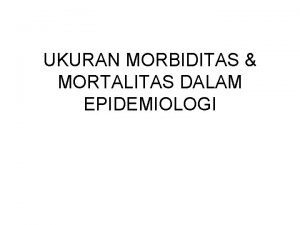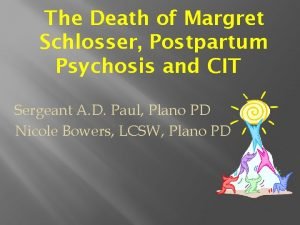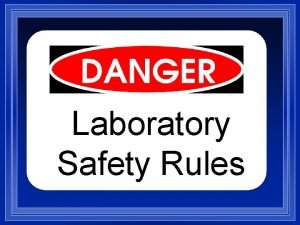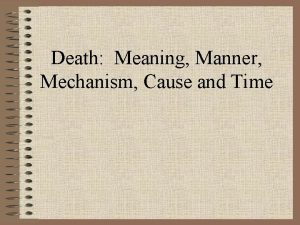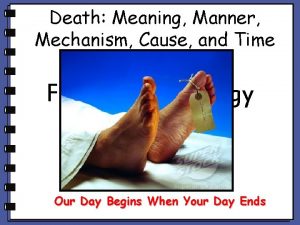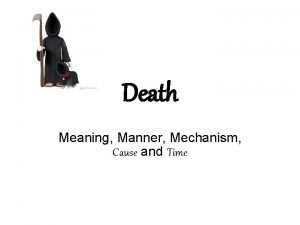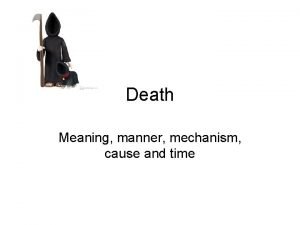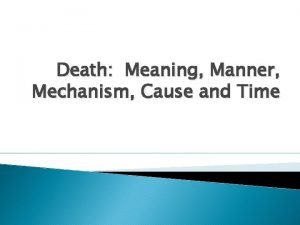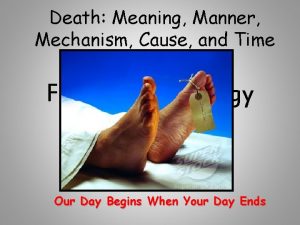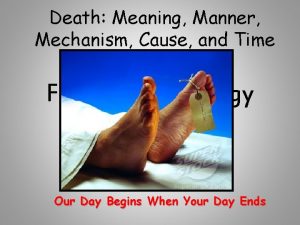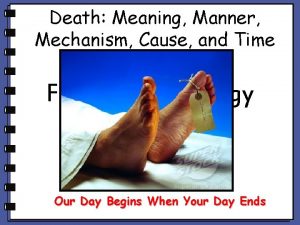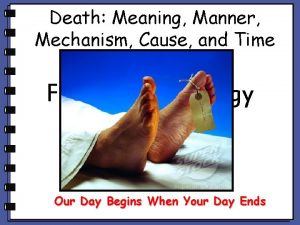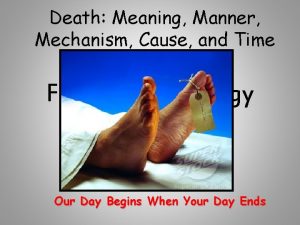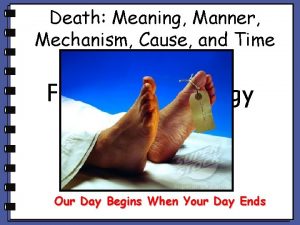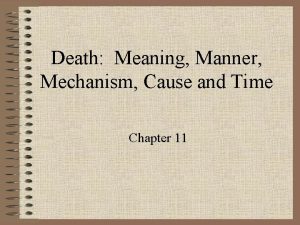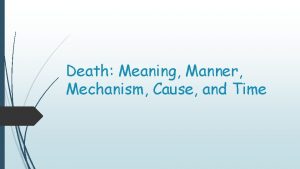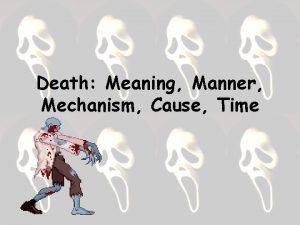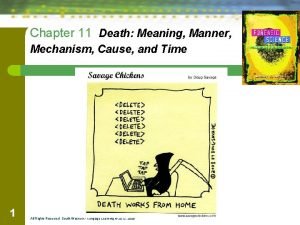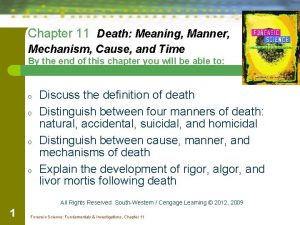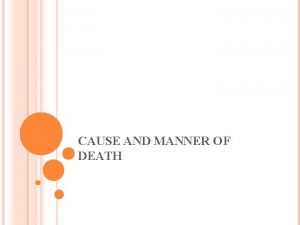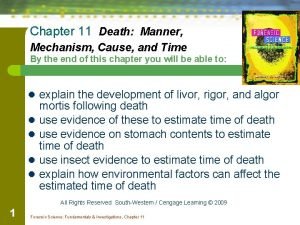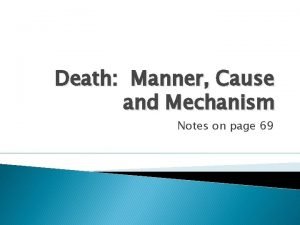Death Meaning Manner Mechanism Cause and Time Death































- Slides: 31

Death: Meaning, Manner, Mechanism, Cause and Time

Death • Death is the permanent termination of the Death biological functions that sustain a living organism. • Physiological death is a process which begins when the heart stops beating. Deprived of oxygen, a cascade of cellular activities begins. • Do all the cells in the body die at the same time? Explain.

Timing: Death is a process rather than an event. • Brain cells can die if deprived of oxygen for more than 3 minutes. • Muscle cells live on for several hours. • Bone and skin cells can stay alive for several days.

Death Misdiagnosis • There are many anecdotal references to people being declared dead by physicians and then "coming back to life", sometimes days later in their own coffin, or when embalming procedures are about to begin.

. • A physician claimed that as many as 2, 700 people were buried prematurely each year in England Wales in the 1800’s. • This lead to fear of being buried alive, and various suggestions were made to test for signs of life before burial, such as pouring vinegar and pepper into the corpse's mouth or applying red hot pokers to the feet or into the rectum. • Interesting Fact: The Fear of being buried alive is called taphephobia. The word “taphephobia” comes from the Greek “taphos” meaning “grave” + “phobia” from the Greek “phobos” meaning “fear” = literally, fear of the grave, or fear of being put in the grave while still alive.

Safety Coffin • • The general fear of premature burial led to the invention of safety devices for coffins. Most consisted of a communications device with the outside world such as a cord attached to a bell that the interred person could ring should he revive after the burial. The fear of being buried alive peaked during the cholera epidemic of the 18 th and 19 th centuries. Interesting Fact: When the Les Innocents cemetery in Paris, France was moved from the center of the city to the suburbs the number of skeletons found face down convinced many people and several doctors that premature burial was very common.

Premature Burials Virginia Macdonald 1851 Virginia Macdonald lived with her father in New York City and became ill, died, and was buried in Greenwood Cemetery, Brooklyn. After the burial, her mother believed that the daughter was not dead when buried. The family tried in vain to assure the mother of the death of her daughter. Finally the mother insisted so strenuously that the family consented to have the body taken up. To their horror, they discovered the body lying on the side, the hands badly bitten, and every indication of a premature burial. Madam Blunden 1896 When Madam Blunden was thought to be dead, she was buried in the Blunden family vault at Holy Ghost Chapel in Basingstoke, England. The vault was situated beneath a boys’ school. The day after the funeral when the boys were playing they heard a noise from the vault below. One of the boys ran and told his teacher. The vault and the coffin were opened just in time to witness her final breath. All possible means were used to resuscitate her but it was unsuccessful. In her agony she had torn frantically at her face and had bitten the nails off her fingers.

Cause of Death-The reason an individual died. They are the diseases or injuries that alter the victim's physiology and lead to death. • • heart attack, Skull fracture, Gunshot wound, Bleeding ulcer Fact: About 150, 000 people die around the world each day from various causes.

Manner of Death-The manner of death is the root cause of the sequence of events that lead to death • The four manners of death are • Natural: Natural deaths result from a natural disease process. Heart attacks, cancers, pneumonias, and strokes are common natural causes of death. It is by far the largest category of death that the ME sees, making up about half of the cases investigated. • Accidental: Accidental deaths result from an unplanned and unforeseeable sequence of events. Falls, automobile accidents, and inhome electrocutions are examples of accidental deaths. • Suicidal: Suicides are deaths caused by the dead person's own hand. Intentional, self-inflicted gunshot wounds, drug overdoses, and selfhangings are suicidal deaths. • Homicidal: Homicides are deaths that occur by the hand of someone other than the dead person.

. Mechanism of Death is the specific change in the body that brought about the cessation of life. • Excessive bleeding • infection Example: A shot in the heart is a cause of death that can lead to one of several mechanisms of death, including exsanguination (bleeding to death) or sepsis (infection that enters the blood stream). Please write an example of a case: You should include a brief description, cause manner and mechanism 10

Example: A man is struck by an intoxicated driver's car and severely injured. The paramedics arrive and transport him to the hospital, where he dies as a result of his injuries. Cause: The blunt trauma from the car may have caused lethal brain injuries, and the driver may be charged in the man's death. Manner: Accident Mechanism: Brain contusion (bruise) On the other hand, if the injuries weren't that severe, and the victim died from internal bleeding that paramedical and hospital personnel failed to recognize Cause: Blunt trauma from the automobile impact Manner: Accident Mechanism: . Exsanguination (excessive loss of blood).

Why is the determination of PMI so important to forensic investigators? PMI-Post Mortem Interval-The time elapsed from the moment of death until a corpse is discovered.

Determining PMI The determination of time of death is of crucial importance forensic investigators, especially when they are . . gathering evidence that can support or deny the stated actions of suspects in a crime. The classical method of estimating time of death is the rate method, which measures postmortem (after death) stages and the types of transformation a body undergoes such as cooling rates stiffening, discoloration stains, degree of putrefaction, adipocere (fat saponification), and maceration (tissue softening due to the presence of liquid).

Determine Time of Death — Determine Time of Death Livor Mortis livor mortis: Process by which blood seeps down and settles into lower parts of body. Lividity : • pooling or settling of blood in tissues after death. • Begins 2 hours after death becomes permanent after 8.

Determine Time of Death — Determine Time of Death Livor Mortis Livor mortis can: • Determine Time of Death • Within 2 -8 hours, can press skin and color disappears • Factors affecting lividity • Ambient temperature, anything that could impede flow of blood to area • Reveal the position of the corpse within first 8 hours • If on back, blood will pool along backside • Reveal if the body was moved • If moved, may show dual lividity from first position and then from second position

Determine Time of Death — Determine Time of Death Rigor Mortis Stiffening of the skeletal muscles after death • • At death, skeletal muscles cannot relax. Without oxygen, calcium accumulates in these muscles. – • • 16 Calcium is used by the body to signal muscle contraction, this accumulation signals the muscles to contract. The muscles become stiff. Rigor mortis starts in the head and works its way down to the legs.

What are some factors that may affect the onset of rigor mortis?

Determine Time of Death — Determine Time of Death Rigor Mortis • 2 -6 hours postmortem (after death), rigor begins in the head • 12 hours postmortem, rigor is complete and throughout the entire body • 15 -36 hours postmortem, the muscle fibers 18 begin to dissolve, and softening begins (rigor mortis starts to end). • 36 -48 hours postmortem, rigor ends and is relaxed throughout the entire body. • Why does rigor mortis end after 36 hours? • What are some factors that may affect rigor mortis?

Determine Time of Death — Determine Time of Death Rigor Mortis Factors that affect rigor mortis – Ambient temperature • (cold = slow rigor) – The weight of the body • (obesity = slow rigor) – The body’s clothing or lack of it – Any illness the person had at the time of death – The level of physical activity at the time of 19 death – Sun exposure

Determine Time of Death — Determine Time of Death Algor Mortis Cooling of the body after death • In death a body no longer generates warmth and begins to cool down. • To find the standard temperature of a corpse, a thermometer is inserted into the liver. • Time of death determined by temperature calculations is expressed as a range of time. – Normal body temperature is 98. 6°F (37°C) 20

Determine Time of Death — Determine Time of Death Algor Mortis Calculations • First 12 hours after death: – Body cools 0. 78 °C (1. 4 °F) per hour • After 12 hours after death: – Body cools 0. 39 °C (0. 7 °F) per hour Example – What is the temperature loss for someone who has been dead for 12 hours? • 0. 78 ° C x 12 hours = 9. 36 ° C 21

Determine Time of Death —Stomach and Intestinal Contents • 4 -6 hours for stomach to empty contents into small intestine 22 • Another 12 hours for the food to leave the small intestine for the large intestine • 24 hours for the food to leave the large intestine

Determine Time of Death —Stomach and Intestinal Contents Example – Determine the time of death from the last meal if food is found in the small intestine Answer: Death occurred 4 - 6 hours after the last meal 23

Scully's autopsie in 'Bad Blood', season 5 of the X files

Determine Time of Death —Stages of Decomposition • Within 2 days – – – • After 4 days – – • The skin blisters. The abdomen swells. Within 6 -10 days. – – 25 Cell autolysis begins following death. Green and purplish staining from blood decomposition. Marbling appearance on the skin. Discoloration of the face. The corpse bloats. Fluids begin to leak from body openings as cell membranes rupture. The skin sloughs off. Eyeballs and other tissues liquefy.

Marbling of skin

Marbling and discoloration of skin seven days after death

Decomposition: Swelling and Discoloration

Body Farm Cadaver after about 15 Days

Skeletonized Remains from the Body farm

Determine Time of Death — Determine Time of Death Insects Forensic Entomology • Within minutes of a death, certain insects arrive to lay their eggs on the warm body. – Blowflies are a common example. • As a corpse progresses through the stages of decomposition, other kinds of insects arrive. 31 – will discuss more in next unit.
 Chapter 11 death meaning manner mechanism cause and time
Chapter 11 death meaning manner mechanism cause and time Cause, manner and mechanism of death worksheet
Cause, manner and mechanism of death worksheet Manner mechanism and cause of death
Manner mechanism and cause of death Ter death certificate
Ter death certificate Proximate cause and ultimate cause
Proximate cause and ultimate cause Proximate causation vs ultimate causation
Proximate causation vs ultimate causation Imprinting biology examples
Imprinting biology examples Subject-verb object adverb examples
Subject-verb object adverb examples Adverbs of manner and modifiers
Adverbs of manner and modifiers What is elapsed time
What is elapsed time Unworthy manner
Unworthy manner Meaning:manner
Meaning:manner Meaning:manner
Meaning:manner Mechanism of death definition
Mechanism of death definition Whmis is an acronym that stands for
Whmis is an acronym that stands for Morbiditas
Morbiditas Dena schlosser husband
Dena schlosser husband Lenin death cause
Lenin death cause Short exposure can cause death
Short exposure can cause death Death of apostles of jesus
Death of apostles of jesus Houdini death cause
Houdini death cause Peter eckersley death
Peter eckersley death Edward fudge cause of death
Edward fudge cause of death Portia white cause of death
Portia white cause of death Lyle alzado cause of death
Lyle alzado cause of death Maria emília miranda
Maria emília miranda Antonio vivaldi cause of death
Antonio vivaldi cause of death Mozart who was born on january
Mozart who was born on january Wolfgang amadeus mozart death cause
Wolfgang amadeus mozart death cause Brock franklin
Brock franklin Chrisomes death
Chrisomes death Be instant in season
Be instant in season
